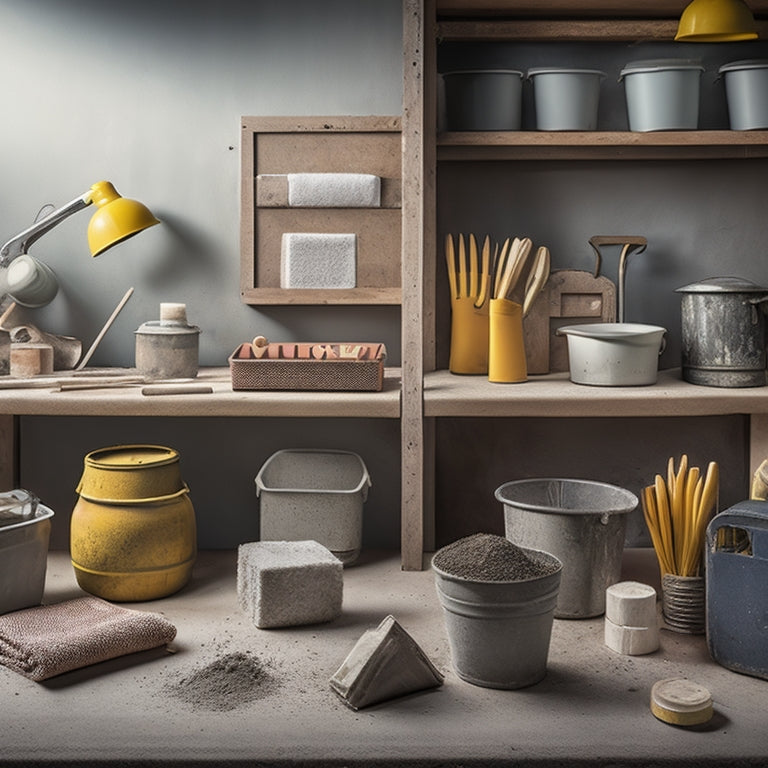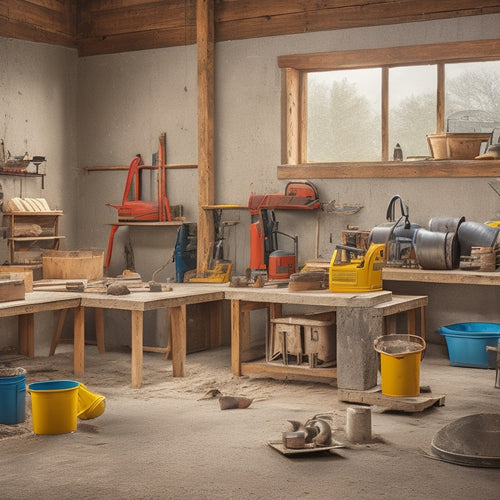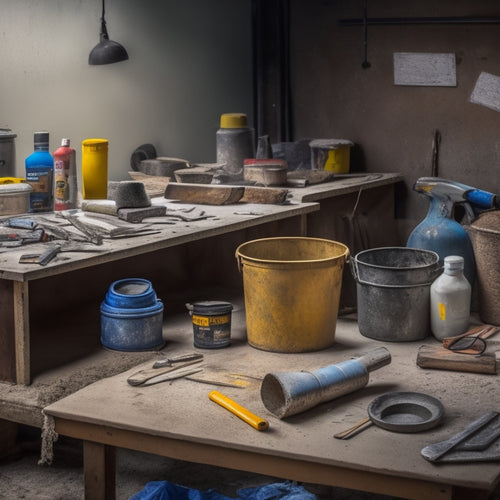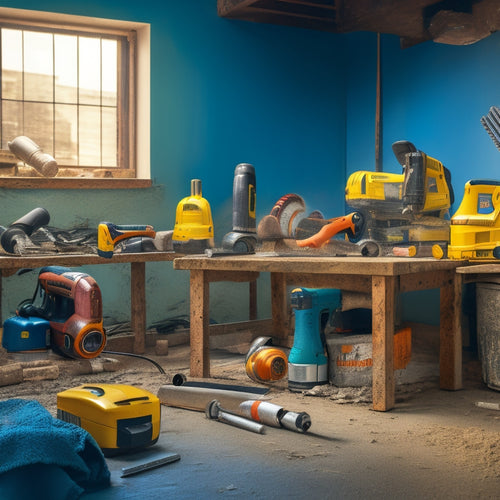
7 Must-Have Tools for Concrete Block Planter Builds
Share
You'll need seven essential tools to build a concrete block planter that's both sturdy and visually appealing. First, a tamping tool guarantees uniform compaction of the soil and gravel base, while a level assures accurate alignment of the concrete block layers. Safety gear, including protective eyewear and durable gloves, is a must-have for protection. A mixing bucket and trowel are necessary for mixing and finishing the concrete, respectively. Additionally, a measuring tape guarantees accuracy, and a drill is required for setting anchors. With these tools, you'll be well on your way to creating a thriving planter - and by exploring further, you'll reveal the secrets to a truly professional-looking build.
Key Takeaways
• Compaction and leveling tools, such as tamping tools and levels, ensure a solid base and prevent structural weaknesses in concrete block planters.
• Safety gear, including protective eyewear and gloves, is essential for reducing the risk of serious injuries during construction.
• Mixing and finishing tools, like mixing buckets and trowels, enable efficient concrete mixing and a professional finish on planter edges.
• Measurement and anchoring tools, including measuring tapes and drills, ensure accuracy and secure anchor setting in concrete block planters.
• High-quality tools with durable materials and ergonomic design enhance comfort, efficiency, and overall project quality during concrete block planter builds.
Tamping Tool for Compaction
You'll need a reliable tamping tool to guarantee the soil and gravel base of your planter is compacted uniformly, as uneven settlement can lead to structural weaknesses and water accumulation issues.
Compaction is essential to prevent settling and secure the planter's structural integrity. A good tamping tool will allow you to achieve the best compaction, which is necessary for a solid foundation.
Mastering tamping techniques is important to reap the compaction benefits. By compacting the soil and gravel base, you'll prevent air pockets and make sure the planter's weight is evenly distributed. This, in turn, will prevent water from accumulating in the planter, reducing the risk of erosion and damage.
Additionally, compaction will improve the planter's drainage, reducing the risk of waterlogged soil and root rot. With a reliable tamping tool and proper techniques, you'll be able to achieve a solid, compacted base that will support your planter's structure and secure its longevity.
Level for Precise Alignment
Accurate alignment of your concrete block planter's layers is essential, and a level guarantees that each course is properly positioned, preventing structural weaknesses and aesthetic issues.
You'll want to ascertain that your level is sturdy, reliable, and easy to read. Look for a level with a magnetic edge that can attach to metal surfaces, making it easier to take precise readings.
When using your level, employ leveling techniques such as checking the planter's sides and corners to verify they're plumb. This will help you identify any deviations in alignment.
Furthermore, develop alignment strategies that involve working from the bottom up, using your level to guide each course as you build. This approach will help you maintain a consistent, level surface throughout the construction process.
Safety Gear for Protection
When building concrete block planters, you'll be working with heavy materials and power tools, which can be hazardous to your health.
You're about to learn why investing in the right safety gear is vital to protecting yourself from serious injuries.
Let's start with the essentials: protective eyewear and durable gloves, which will be your first line of defense against flying debris and rough handling.
Protective Eyewear Essentials
Protective Eyewear Essentials
Wear protective eyewear that meets ANSI Z87.1 standards to shield your eyes from debris, dust, and chemical splashes that can occur during concrete block planter builds. This is a vital safety measure to prevent serious eye injuries.
When selecting protective eyewear, consider the following key features:
| Feature | Description | Importance |
|---|---|---|
| Lens Material | Polycarbonate or Trivex lenses provide impact resistance | High |
| Frame Style | Wraparound frames offer better protection than traditional frames | Medium |
| Coatings | Anti-fog and scratch-resistant coatings enhance visibility and durability | Medium |
| Ventilation | Ventilation systems reduce fogging and improve airflow | Low |
Choose eyewear with a combination of these features to guarantee superior protection. Remember, safety standards are in place for a reason, so don't compromise on your eye safety. By wearing the right protective eyewear, you'll be able to focus on your concrete block planter build with confidence and peace of mind.
Durable Gloves Matter
While safeguarding your eyes is essential, your hands are equally at risk during concrete block planter builds, making durable gloves a must-have to prevent injuries and guarantee a secure grip.
You'll be handling heavy blocks, mixing concrete, and using tools that can cause cuts, abrasions, and punctures. Without proper hand protection, you're exposing yourself to potential harm.
Invest in gloves that prioritize glove durability and hand protection. Look for features like thick, puncture-resistant palms, reinforced fingertips, and a snug fit to prevent blisters.
You'll want gloves that can withstand the rigors of concrete block handling and tool use. Consider gloves with grip patterns on the palms to verify a secure hold on wet or slippery surfaces.
Don't compromise on glove durability – it's a critical aspect of hand protection. Cheap or flimsy gloves may seem like a cost-effective option, but they can fail when you need them most.
Opt for high-quality, heavy-duty gloves that will keep your hands safe and protected throughout your concrete block planter build.
Mixing Bucket for Concrete
When you're preparing to mix concrete for your planter build, you'll need a reliable bucket that can handle the job.
You'll want to contemplate a bucket that can hold the right amount of concrete for your project, as well as one made from durable materials that can withstand the mixing process.
Concrete Capacity Matters
Your mixing bucket's capacity determines how much concrete you can mix at once, directly impacting the efficiency of your block planter build. You need to evaluate the concrete volume you can handle comfortably, taking into account the weight considerations of the mixed concrete. A larger bucket may seem appealing, but it can be cumbersome to handle, especially when filled to capacity.
Here are some factors to evaluate when choosing a mixing bucket:
-
Concrete volume: Calculate the amount of concrete needed for your planter build and choose a bucket that can handle that volume.
-
Weight considerations: Assess the weight of the mixed concrete and confirm you can lift and pour it safely.
-
Batch size: Determine the ideal batch size for your project and choose a bucket that can accommodate it.
-
Mixing efficiency: A larger bucket may not always be more efficient, as it can be harder to mix the concrete thoroughly.
-
Storage and portability: Evaluate the storage space and portability of the bucket when not in use.
Bucket Material Quality
You'll want to select a mixing bucket made from a material that can withstand the rigors of mixing and handling concrete, as subpar materials can compromise the integrity of your block planter build.
A bucket that's durable and resistant to abrasion is crucial, as it'll be subjected to the rough texture of aggregate and the constant scraping of mixing tools. Look for buckets made from heavy-duty materials like polyethylene or steel, which offer exceptional bucket durability.
When choosing a mixing bucket, consider the bucket capacity as well. A larger bucket may seem convenient, but it can be cumbersome to handle and may lead to inconsistent mixing.
A bucket with a capacity of 2-5 gallons is usually ideal for most concrete block planter builds. This size range allows for efficient mixing and handling while minimizing the risk of material waste.
Mixing Ease Guaranteed
Selecting a mixing bucket specifically designed for concrete guarantees a hassle-free mixing experience, saving you time and effort in the process.
You'll appreciate the sturdy construction and ergonomic design that allows for comfortable mixing, even with thick concrete mixes.
A good mixing bucket will also enable you to perfect your mixing techniques, making certain a consistent blend of concrete and additives.
Here are some key features to look for in a mixing bucket:
-
A heavy-duty, rust-resistant material that can withstand harsh concrete environments
-
A large, comfortable handle that makes it easy to mix and pour
-
Measuring markers or gradations to guarantee accurate mixing ratios
-
A non-slip bottom that prevents the bucket from sliding around during mixing
-
A lip or spout that makes pouring concrete into molds easy and mess-free
Trowel for Smoothening Edges
For a professional finish, use a high-quality trowel to smoothen the edges of your concrete block planters, removing any excess material or imperfections. This essential tool allows you to refine the edges, creating a clean and polished look that elevates the overall aesthetic of your planters.
When selecting a trowel, opt for one with a sturdy handle and a flat, wide blade, typically between 4-6 inches in length. This will provide you with the necessary leverage and control to smooth out the edges.
Mastering trowel techniques is fundamental for achieving a flawless edge finish. Hold the trowel at a 45-degree angle, applying gentle pressure as you work your way along the edge. Use long, sweeping motions to remove excess material, and then switch to shorter strokes to refine the surface.
Remember to keep the trowel clean and dry to prevent it from sticking to the concrete. With practice and patience, you'll develop the skills necessary to achieve a razor-sharp edge finish that adds a touch of sophistication to your concrete block planters.
Measuring Tape for Accuracy
Measure twice, cut once - a mantra that holds especially true when working with concrete block planters, where accuracy is key to achieving a sturdy and visually appealing structure.
As you begin your build, a reliable measuring tape becomes an indispensable tool in your arsenal. With a good measuring tape, you can guarantee that your blocks are aligned, your corners are square, and your measurements are precise.
To get the most out of your measuring tape, keep the following measuring techniques in mind:
Always use a tape with high tape accuracy to minimize errors.
Take multiple readings to verify your measurements.
Use a tape with clear, easy-to-read markings to avoid mistakes.
Consider using a tape with a built-in calculator to simplify complex calculations.
Store your tape in a dry, protected area to prevent damage and guarantee consistent readings.
Drill for Anchor Setting
Your drill becomes an essential ally when setting anchors in your concrete block planter, guaranteeing a secure hold that can withstand outdoor elements.
When choosing a drill for anchor setting, you'll want to take into account the type of drill that best suits your needs. A cordless drill is ideal for convenience and portability, while a corded drill provides consistent power for heavy-duty applications.
When it comes to anchor materials, you'll need to select the right type for your planter's specific requirements. For instance, plastic anchors are suitable for lighter loads, whereas metal anchors provide added strength and durability for heavier loads. It's vital to match the anchor material to the weight and size of your planter, as well as the surrounding environment.
To guarantee a secure hold, make sure to drill pilot holes that are slightly smaller than the anchor's diameter. This allows the anchor to expand properly, creating a strong bond with the concrete.
Frequently Asked Questions
What Is the Ideal Ratio of Cement to Aggregate for Concrete Mix?
When you're mixing concrete for your planter build, getting the ideal ratio of cement to aggregate is essential.
You'll want to aim for a mix of 1 part cement to 2-3 parts aggregate, depending on the type of aggregate you're using.
Different aggregate types, like crushed stone or pea gravel, require varying mixing techniques.
Can I Use a Shovel Instead of a Tamping Tool for Compaction?
When it comes to compaction, you might be tempted to grab a shovel, but don't.
While a shovel can provide some compaction, its efficiency pales in comparison to a dedicated tamping tool.
Proper compaction techniques require a tool that can apply consistent, targeted pressure.
A shovel can't deliver that, leading to uneven density and potential structural issues.
Invest in a tamping tool for ideal results.
How Do I Prevent Mold Growth on My Concrete Block Planters?
You'll be inundated with mold growth on your concrete block planters if you don't take preventative measures!
To avoid this, you'll need to prioritize mold prevention and planter maintenance.
Start by ensuring good drainage holes in your planters, then apply a waterproof sealant to protect the concrete.
Regularly clean your planters with a mild detergent, and dry them thoroughly to prevent moisture buildup.
Are Gloves Necessary for Handling Concrete Block Planters?
When handling concrete block planters, you're right to wonder if gloves are necessary. The answer is yes, they're vital for safety precautions.
Concrete can be abrasive, and the alkaline nature of the material can cause skin irritation. Wearing gloves provides essential hand protection, preventing scratches and potential long-term damage.
Invest in a good pair of heavy-duty gloves to guarantee your hands remain protected and comfortable throughout the project.
Can I Use a Regular Bucket Instead of a Mixing Bucket?
When mixing concrete, you'll want to use a bucket specifically designed for the task. While it might seem like a regular bucket could work, it's not the best choice.
You need a bucket that allows for efficient mixing techniques, like a sturdy handle and a shape that prevents material from getting stuck in corners.
Bucket alternatives, like a wheelbarrow or mixing tub, can also work, but a dedicated mixing bucket is still your best bet for a successful mix.
Conclusion
You've got the right tools, now it's time to get to work!
Remember, 'measure twice, cut once' - it's especially vital when building concrete block planters.
With these 7 must-haves, you'll be well on your way to creating a sturdy and beautiful planter that'll stand the test of time.
Don't rush the process, and you'll be rewarded with a stunning result that'll make all your hard work worth it.
Related Posts
-

What Tools to Rent for a Concrete Home Reno
When tackling a concrete home renovation, you'll need to rent a variety of specialized tools to get the job done. For...
-

3 Best Tools to Buy for Concrete Repair Online
When buying tools for concrete repair online, you'll want to research multiple retailer options to find the best prod...
-

Essential Power Tools for Concrete Block Construction
When building with concrete blocks, you'll need a range of power tools to cut, drill, mix, and finish the blocks to g...


